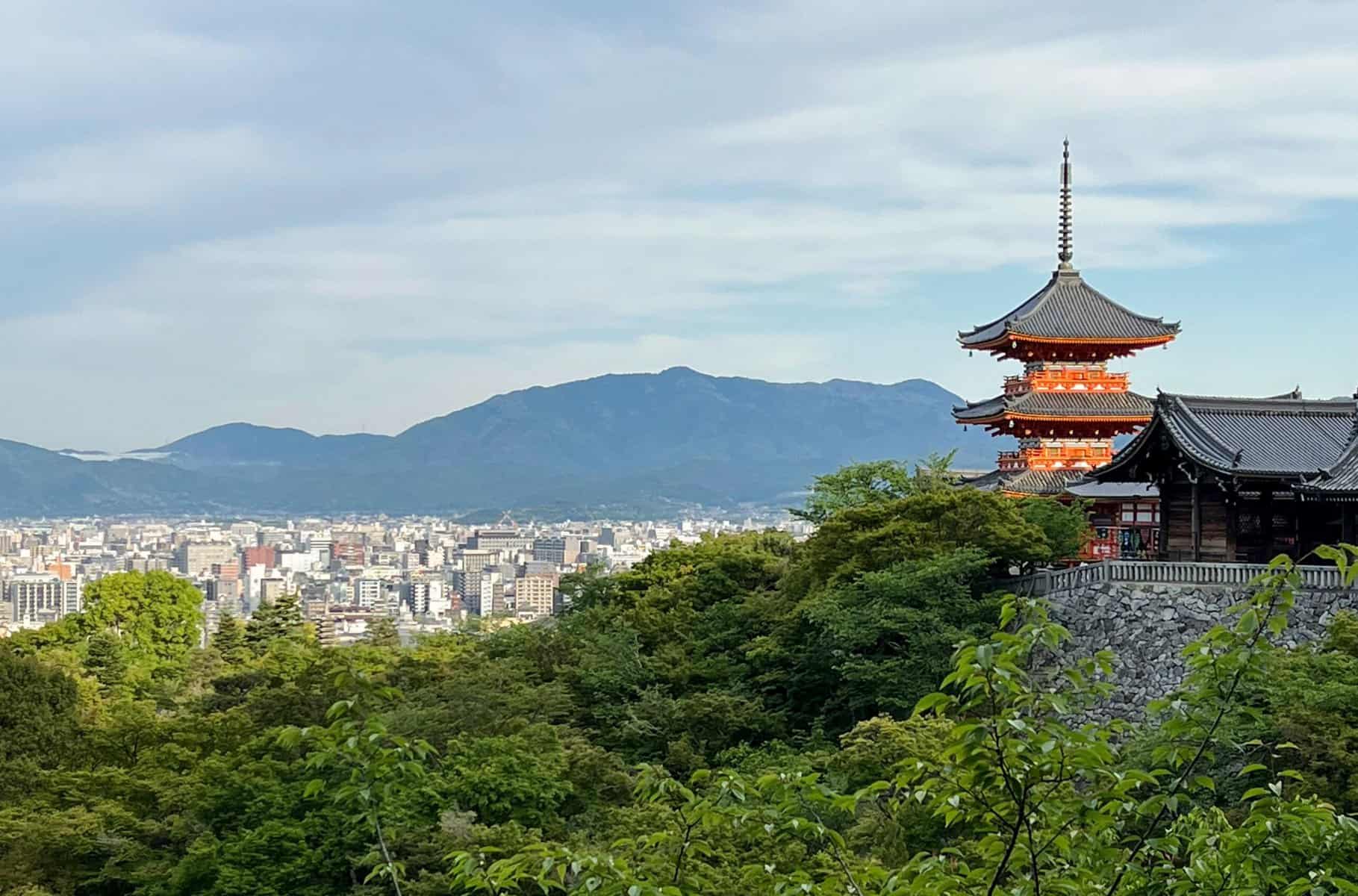The Architecture of Kyoto: City of 10,000 Shrines
While the official tally of Shinto shrines in Kyoto is closer to 400, the city’s nickname does capture the impression it makes. There are also over 1,600 Buddhist temples – each with a minimum of seven distinct buildings – many of which boast dozens of subtemples. And that’s just the religious complexes. Kyoto has so much extraordinary architecture that it’s nearly impossible to do justice to individual structures in a general guide. Hence the proliferation of lists, from official honors (UNESCO World Heritage sites, National Treasures, Important Cultural Properties, etc.) to thematic highlights. But their information is cursory, and rarely factors in travel time or crowd levels.
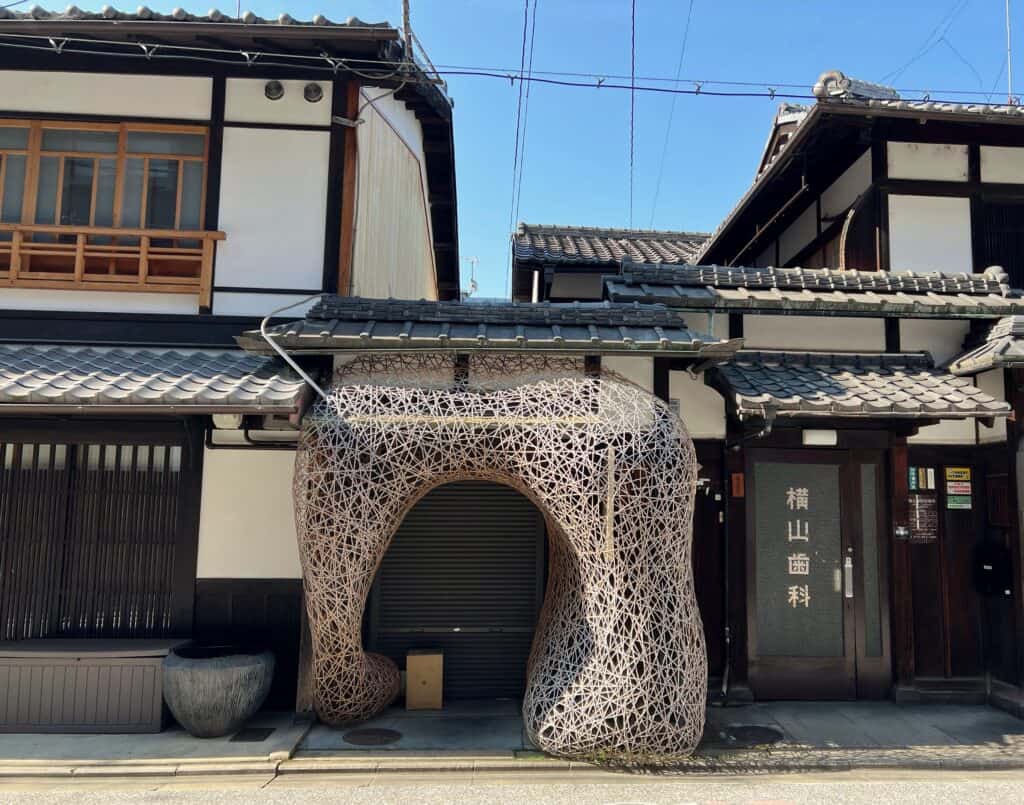
We spent a very busy (and blissful) week in Kyoto, with loads of research done before and afterwards. The following collection of sites is for architecture fans who want to experience the city’s full range of building types and styles, including a mixture of famous and under-the-radar monuments. In order to maximize time, we’ve prioritized sites which are easily accessible via the efficient train and subway system. All sites are marked in our Google map.
Orientation


Kyoto began back in the Jomon Period (14,000 to 300 BCE), with settlements at the foot of the Higashiyama Mountains. Eventually the city spread across the entire valley, but the area east of the river remains the historic core. Northern Higashiyama includes the Philosopher’s Path (a string of famous temples and shrines) and the university-museum district. The tree-lined Shirakawa Canal connects to Southern Higashiyama.
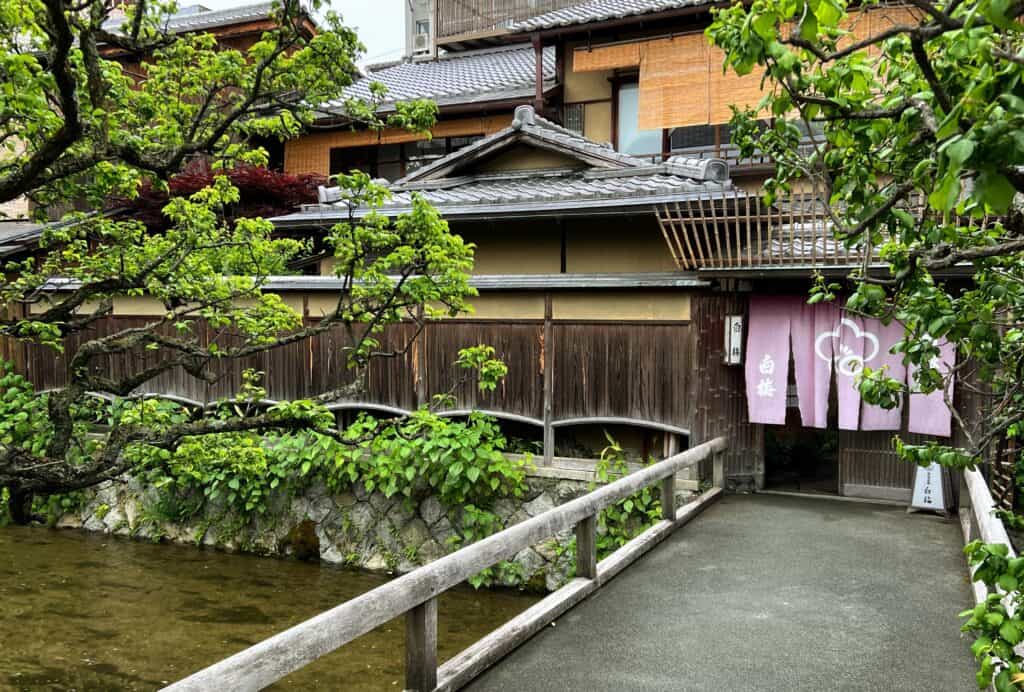
Stretching out from Shijo Bridge, the Gion district (Japan’s original geisha quarter) is a tour magnet by day as well as night. Maruyama Park and the lanes below it feature wall-to-wall temples, shrines, and traditional townhouses. Below Sannenzaka Slope, the sights – and the crowds – begin to thin again. Central Kyoto lies across the river from Higashiyama. Besides the city’s transportation hub, it also offers a mixture of old and new buildings.
Table of Contents
Southern Higashiyama: Sannenzaka walk, Kiyomizu-dera, Kawai Kanjiro’s House, Kennin-ji
Northern Higashiyama: Nanzen-ji, Eikan-do, Ginkaku-ji (Silver Pavilion)
Central Kyoto: Kyoto Station, Kyoto Tower, Higashi-Hongan-ji and Nishi-Hongan-ji, Nijo Castle
Northern Kyoto: Kinkaku-ji (Gold Pavilion), Garden of Fine Arts and Kyoto Concert Hall, International Conference Center
Southern Kyoto and Uji: Katsura Imperial Villa, Fushimi Inari, Daigo-ji, Byodo-in (Uji)
Other Recommendations and Further Reading
Southern Higashiyama
Sannenzaka area walk
Many consider the gently sloping streets between Kiyomizu-dera and Gion to be the most picturesque part of Kyoto. To experience them without shoulder-to-shoulder crowds, we recommend exploring the area in the early morning .


Starting at the bottom of Maruyama Park, a lane called Nene-no-michi runs through wall-to-wall temples. After passing pocket-sized Ishibe Koji road, it runs to a larger street called Ishin-no-michi. From there, Ninenzaka Path offers prime views of Hogan-ji’s Yasaka Pagoda along the way down to Sannenzaka Path. The pedestrian lanes are lined with kyo-machiya, traditional two-story townhouses with a business in front and living quarters in the rear. Narrow street fronts reduced taxes, so property owners compensated with plots deep enough to earn the nickname “eel bed”.
Kiyomizu-dera
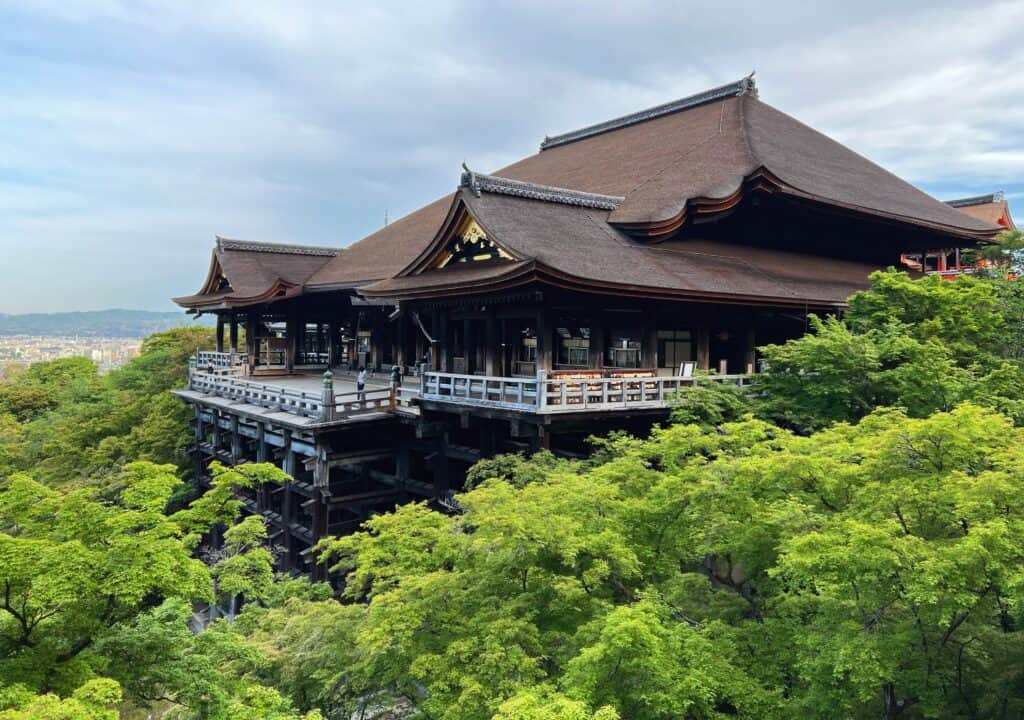
One of Japan’s most beloved temples, Kiyomizu-dera gets 12 million visitors each year. By day, it’s a circus, but at dawn it still feels full of magic. Instead of clinging to the hillside, the temple complex is built out on an enormous (and nail-less) wooden scaffold overlooking a ravine of glowing leaves. The entrance features dragon guardians instead of the usual lion-dog statues, and it’s easy to imagine them swirling over the hillside.
For visiting information, see the Kiyomizu-dera website.
Kawai Kanjiro’s House
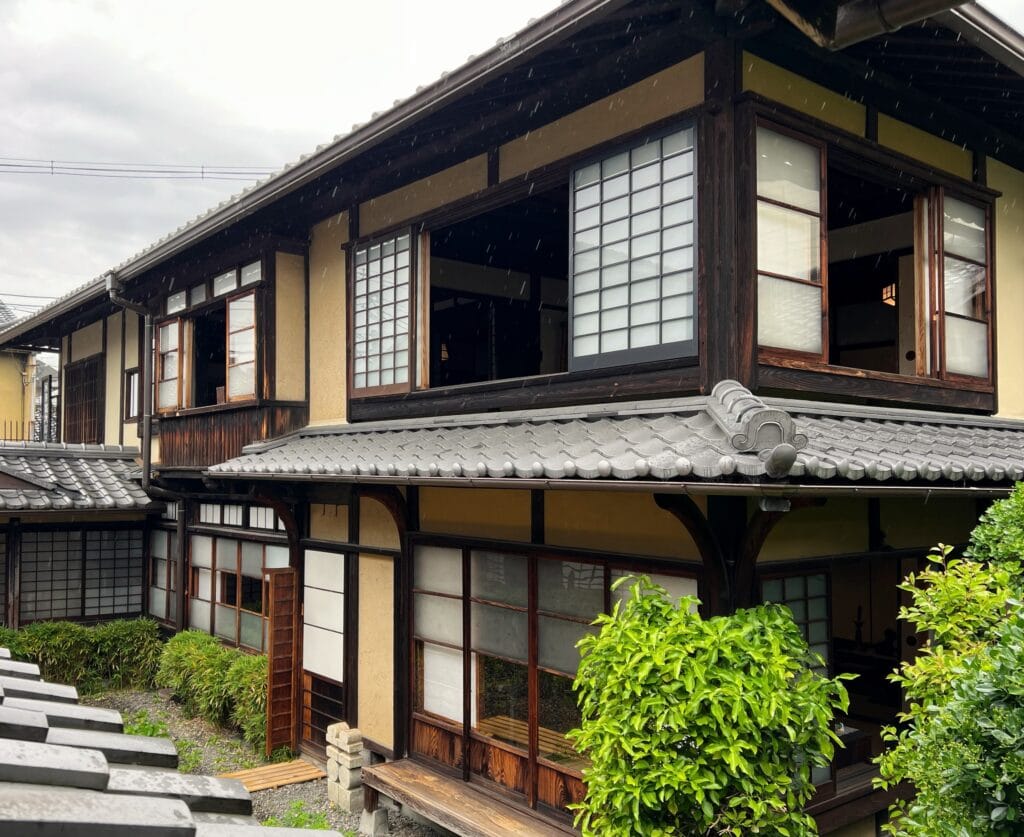
Chawanzaka, or “Teapot Lane”, leads from Kiyomizu-dera to Gojo-dori Street and away from major tourist routes. It’s a short walk to the preserved home of Kawai Kanjiro, one of Japan’s greatest potters of the twentieth century and a major proponent of craftsmanship in the modern era. His house follows traditions but doesn’t feel constrained by them. For instance, it surrounds the age-old central hearth with a double-height space which could work in a contemporary building.

Unlike the near-empty rooms found in so many other historic properties, Kanjiro’s home is full of things to look at, sit on, or hold. In true Japanese style, he made art part of daily life with everything from ceramics to carved furniture and sculptures. His workspace in the back includes an old-school hillside kiln, which is a treat for anyone who can’t make it to one of Japan’s ancient ceramic centers.
The property does not currently have a secure website to link to, but visiting information can be found here.
Kennin-ji
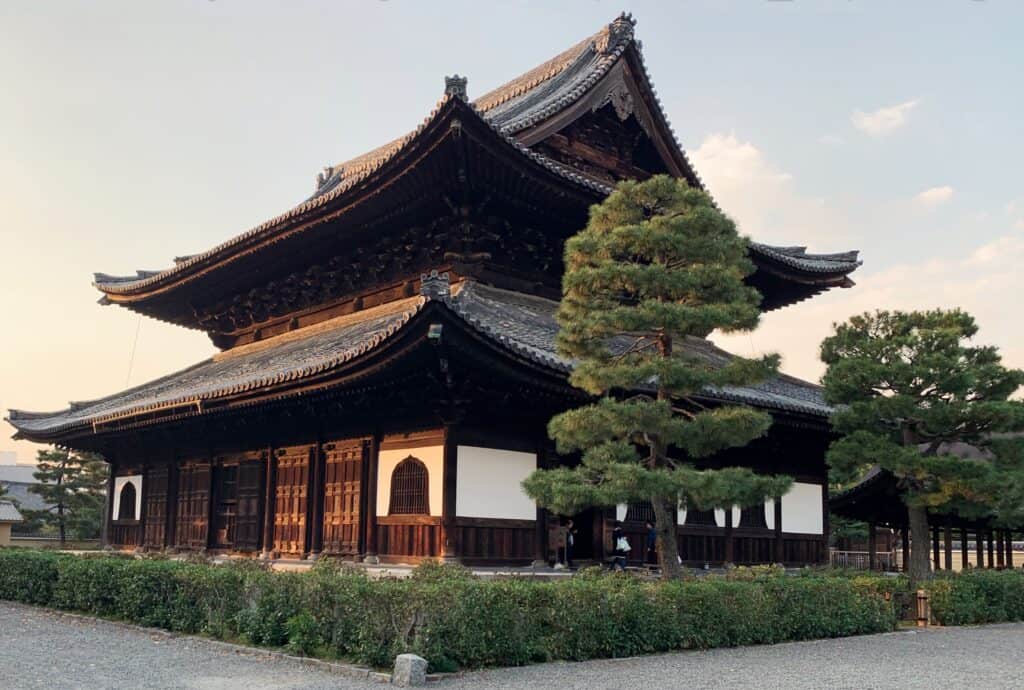
Established in 1202, Kennin-ji is the oldest Zen temple in the city, and is known as one of Kyoto’s five major Zen complexes. Its founder, the monk Eisai, based the design on the Chinese monasteries he had studied in. Wars and fires took their usual toll over the centuries; surviving structures include the Imperial Messenger Gate from the Kamakura period (1185-1333) and the Abbot’s Quarters of 1599. The latter includes examples of the bell-shaped katomado (“fire window” or “flower head window”) first developed in Zen temples.


Kennin-ji’s sizable array of art includes old and new in multiple formats – from giant dragons writhing across the ceiling to a line of tiny monks dancing along sliding doors. Remarkably peaceful given its location in heavily-touristed Gion, Kennin-ji invites everyone to sit and contemplate its gardens and art collection. For visiting information see the Kennin-ji website.
This article provides a nice introduction to Rinzai Zen Buddhism and Kennin-ji’s art.
Northern Higashiyama
The Philosopher’s Path
With a string of exceptional temples and shrines along a tree-lined canal, the path (Tetsugaku No Michi) takes its name from philosopher Nishida Kataro, who made the two-kilometer route part of his daily commute to Kyoto University. It runs along the edge of Northern Higashiyama, tucked between Yoshida Hill and the eastern mountain chain. The path starts in the vicinity of the Nanzen-ji temple complex and follows to Ginkaku-ji (a.k.a. the Silver Pavilion). For more on the area, see our post The Temples and Gardens of Kyoto’s Philosopher’s Path
Nanzen-ji
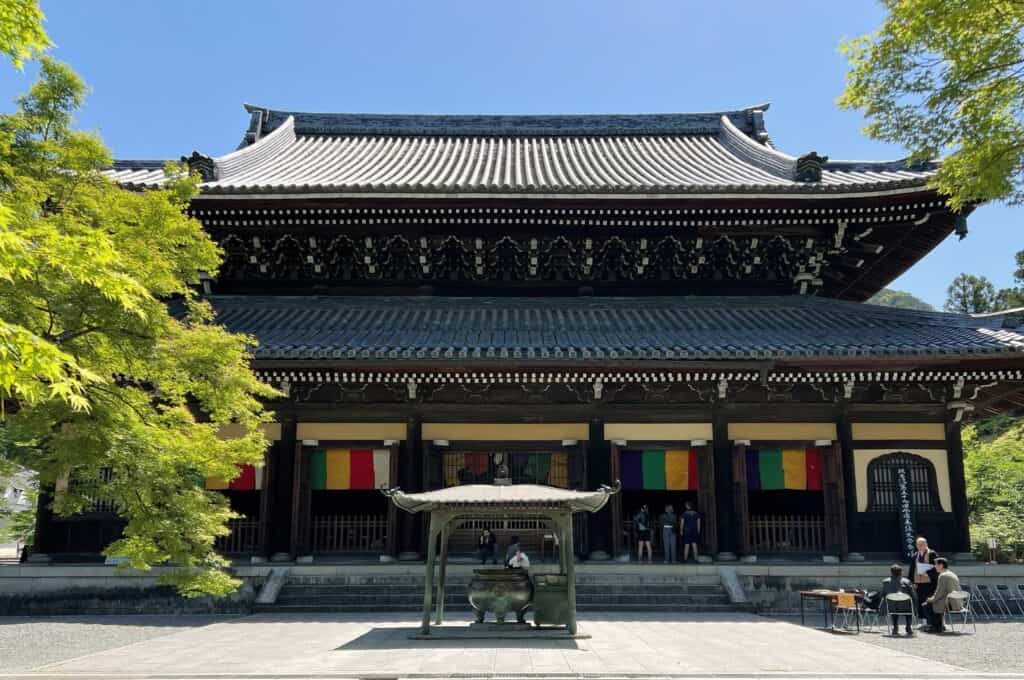
Nanzen-ji is a vast complex, with a dozen sub-temples both in and around the main precinct. As the headquarters of the Zen Rinzai sect, it retains a prominent role in Kyoto’s Buddhist community. Founded in 1291, it was ranked above Kyoto’s five great Zen temples. Today the property is only a third of its original size, thanks to the Meiji government’s seizure of Buddhist properties in the 19th century.
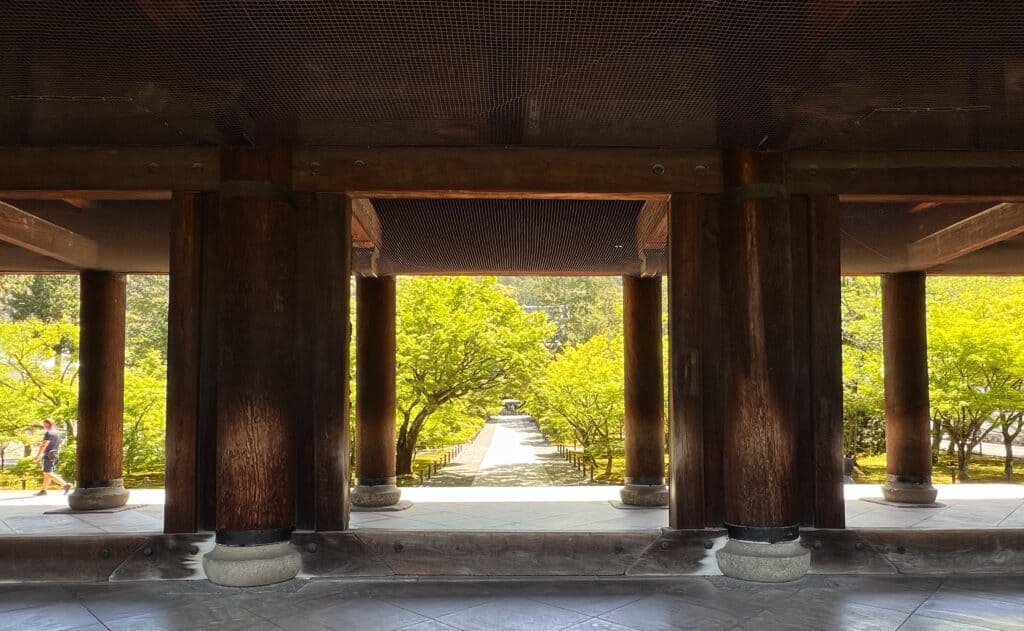
The massive Sanmon gate is the stuff of legends, featured in poetry and Kabuki theater as well as the movie Lost in Translation. The current version dates to 1628, when the original was rebuilt after one of the site’s many disastrous fires. A small fee allows access – via a very steep set of stairs – to the panoramic view at the top. Near the main shrine, a Roman-style brick aqueduct brings water from Lake Biwa to the city, with a small amount siphoned off to create a waterfall.
For visiting information, see the Nanzen-ji website.
Eikando-ji
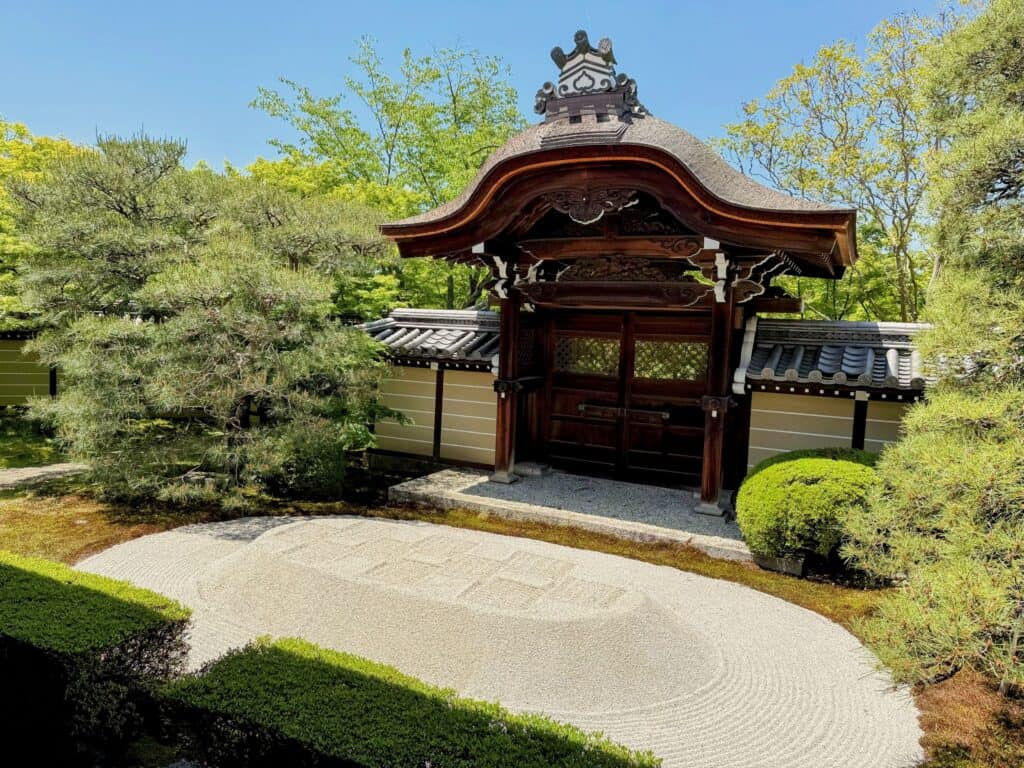
Beyond the fall foliage for which Eikan-do is famous, this ninth-century temple complex takes the integration of architecture and landscaping to extraordinary heights. Walkways wind around buildings and small gardens, alternately hiding and revealing various levels.


Landscaped scenes emerge with every turn. The Zen garden uses white sand pressed into geometric shapes to contrast with the dark wooden Karamon Gate. Beyond it lies the extraordinary Garyu-ro, or Sleeping-Dragon Corridor. Built without nails, the covered stairway traces the contours of the hillside with sinuous curves. It leads up to the Tahoto, a pagoda form with just two storeys found only in Japanese temples built during the Heian Period.
For visiting information, see the Eikan-do website.
Ginkaku-ji (Silver Pavilion)
Temples and palaces alternated on the site for centuries until the tumultuous end of the 1400’s, when shogun Ashikaga Yoshimasa masterminded the current iteration as a refuge from the war-torn city. Yoshimasa sponsored an artistic movement with a huge influence on everything from poetry and tea ceremonies to architecture and garden design. His “retirement villa” was turned into a Zen temple when he died in 1490.
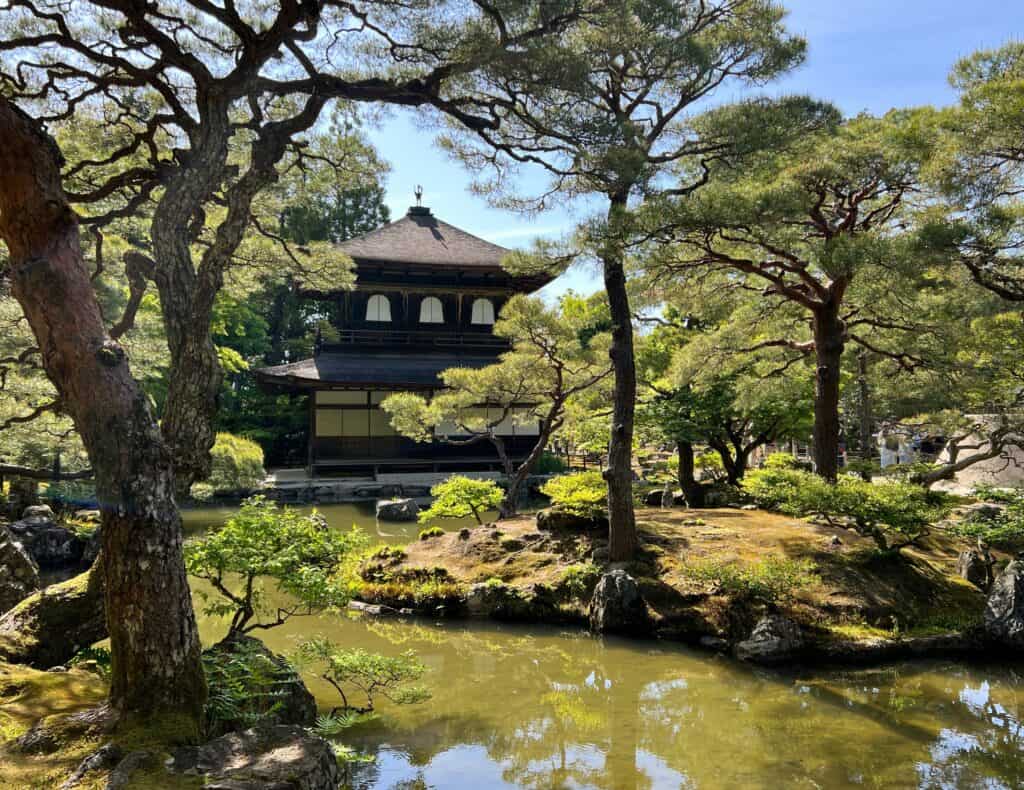
Visits to Ginkaku-ji follow a circular route which begins next to the iconic Kannon Hall, better known as the Silver Pavilion. Although Yoshimasa used his grandfather’s Golden Pavilion as a model, there is no evidence he planned to coat it in silver. One theory for the nickname suggests that it may have appeared silver in the moonlight when it had a coat of black lacquer. The Silver Pavilion and the nearby Togudo are the only two structures surviving from the original ensemble.
For visiting information see the Ginkaku-ji website.
Central Kyoto
A handful of buildings in a small area make an ideal introduction to the city’s architecture, both old and new. For those arriving in Kyoto by train, luggage storage lockers make it easy to pause en route to other neighborhoods.
Kyoto Station


One of Japan’s biggest buildings, Kyoto station doesn’t seem overly large from the outside. Inside it’s a city within a city with a great use of vertical space. The structure’s core blends interior and exterior, and the top level has a garden area with city views. Underground shops and services extend the available volume.
Kyoto Tower
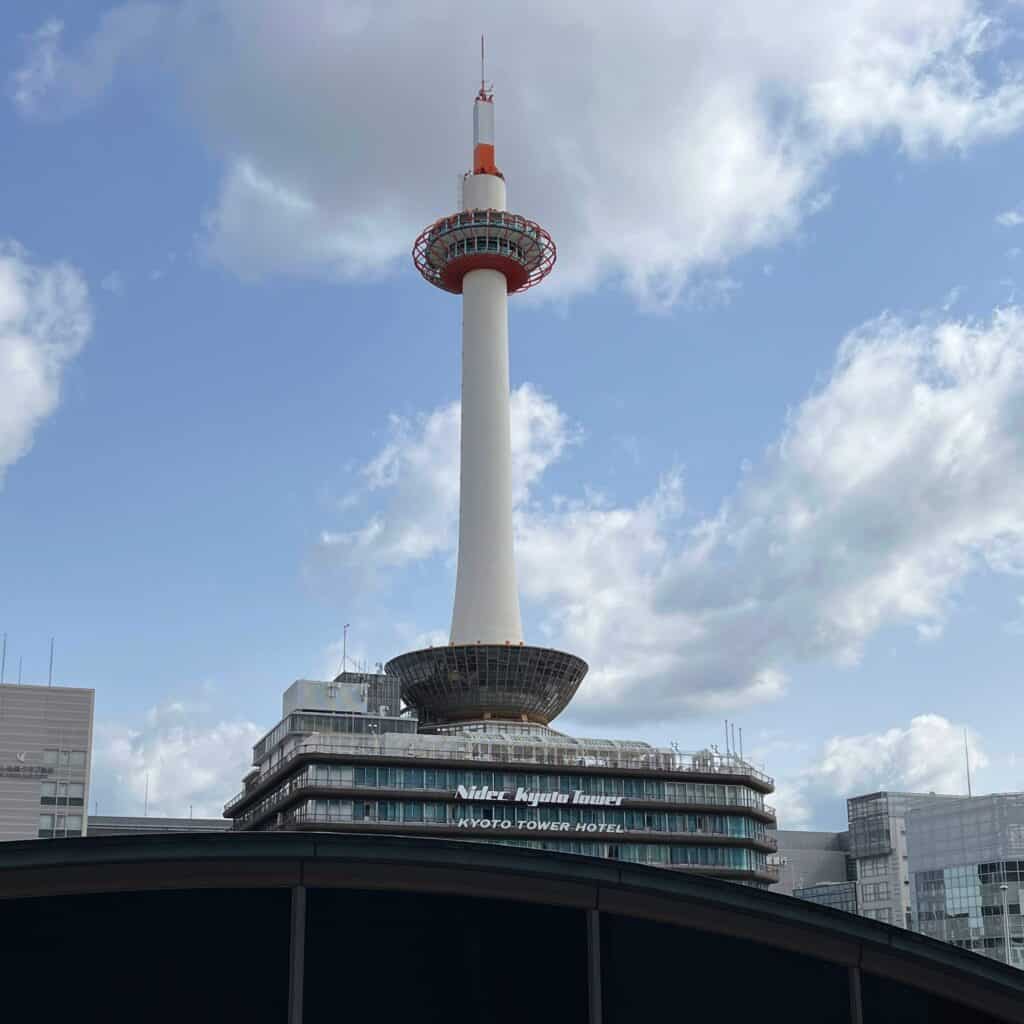
The 1964 structure continues to divide opinions, both for its ultra-modern appearance and for its height. With a spire at 131 meters or 430 feet, it remains the tallest building in the city. While most extremely tall structures use lattices rather than solid forms to reduce weight, the Kyoto Tower features stacked steel rings covered with a lightweight sheathing. A nine-story box under the spire houses most of the property’s amenities, apart from the observation deck with 360-degree views. See the Kyoto Tower website for visiting information.
Higashi-Hongan-ji and Nishi-Hongan-ji Temples
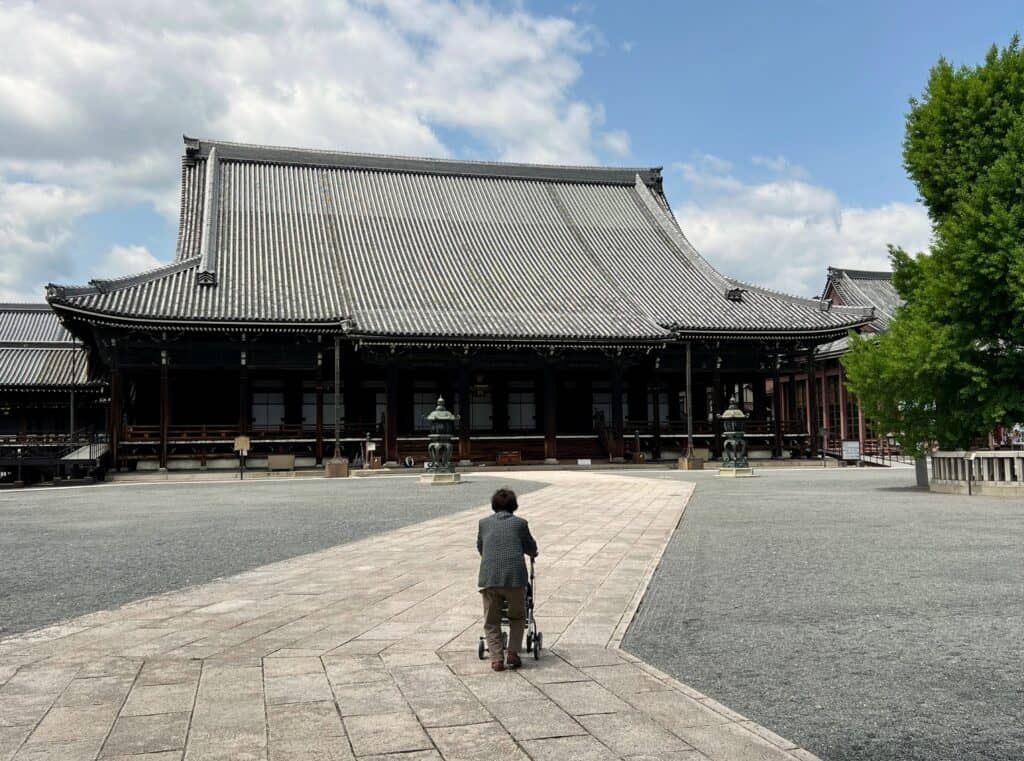
The two temples are twin branches of the Jodo Shinsu sect, split apart for political reasons rather than theological differences. Built just a few blocks apart at the close of the 16th century, they became known as Higashi (Eastern) and Nishi (Western) Hongan-ji. UNESCO ranks only the latter as a World Heritage Site largely because nearly it survived a devastating 1864 fire nearly intact, while the former had to be rebuilt.
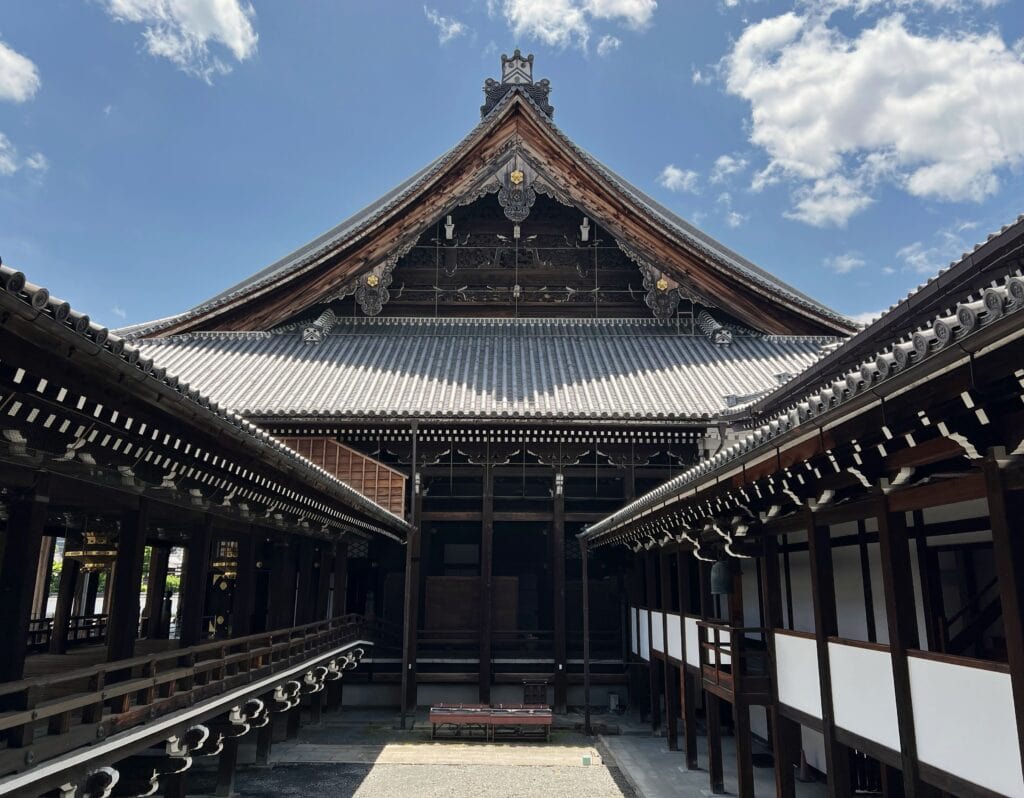
Nishi-Hongan-ji’s treasures include the Karamon Gate, nicknamed the All Day Gate in reference to the amount of time one can spend admiring the colorful carvings. Inside some of the buildings, sharp-eyed observers may spot repair plugs in the wooden walls, some carved into fanciful shapes. A trio of them are pictured at the bottom of the Precinct Guide on the Nishi Hongan-ji website.
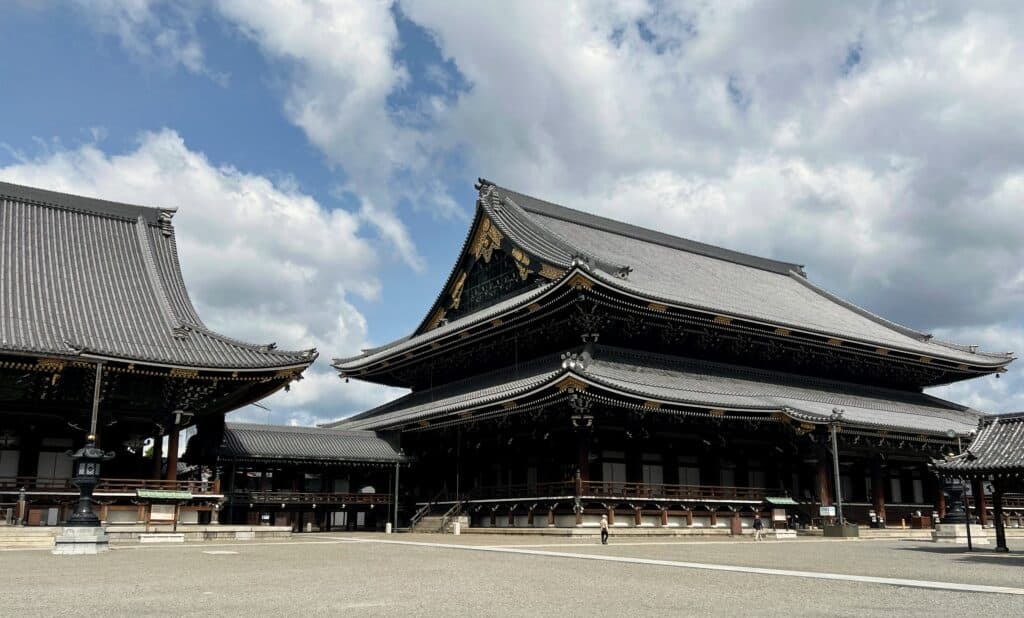
While many Japanese temples are designed to blend into their surroundings, Hongan-ji uses minimal landscaping to let the architecture stand out. The Founder’s Hall is Kyoto’s largest wooden structure, topped by a classic hip-and-gable roof with 175,000 tiles cascading in shimmering lines.
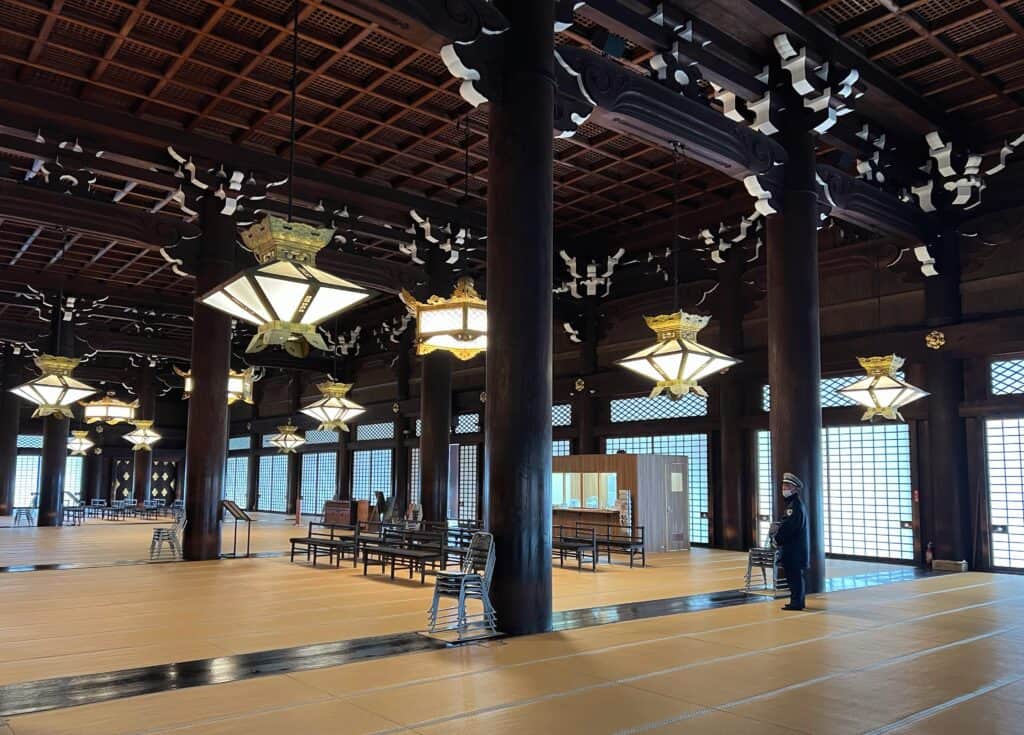
At once weighty and graceful, the exterior conceals a second roof suspended inside. The double-roof system not only worked better in Japan’s wet climate, it also allowed low ceilings better suited for living at floor level. Transporting the structure’s gargantuan pieces of lumber from the mountains required dedication and some creative engineering – including special ropes woven from the hair of female devotees.
The temple’s gardens, located a few blocks away, include a curious little gatehouse (the Bokakaku) on the pond. For visiting information, see the Higashi Hongan-ji website.
Nijo Castle
Built at the behest of Tokugawa Ieyasu, who finally unified Japan at the end of the 16th century, Nijo castle is the best place in Kyoto to study the architecture of power. Tokugawa’s Kyoto residence establishes his strength at the very entrance, with the opulent Karamon gate.
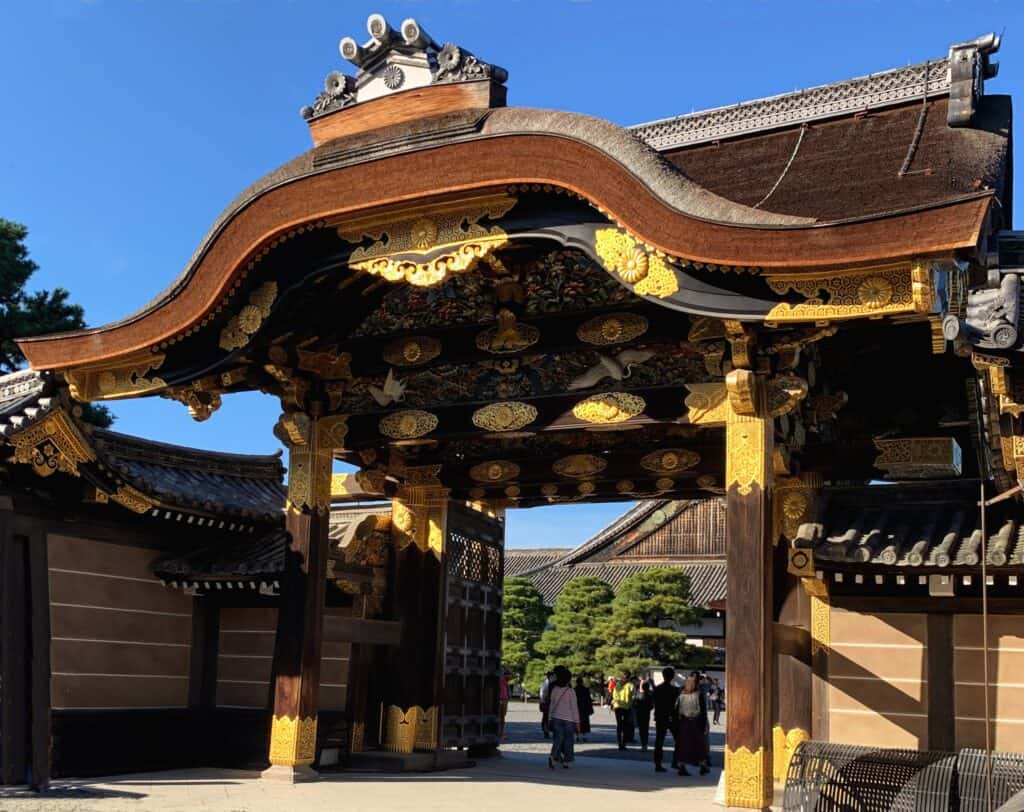
Beyond it the Ninomaru Palace was designed to filter visitors through a long line of buildings, with the end reserved exclusively for the shogun and his family. In the L-shaped spaces, higher levels and open sightlines were reserved for those of higher status. The shogun’s place was often backlit for extra drama.
As a UNESCO World Heritage site, the castle is best visited first thing in the morning. The extensive gardens get even more crowded during spring bloom and fall foliage peaks. Honmaru, the inner castle, is considered less historic than Ninomaru but does have a nice view of the property and surroundings from the keep.
Nijo Castle is a 10 minute walk from the Nijojo-mae station on the Tozai line. For visiting information see the Nijo Castle website.
Northern Kyoto
Kinkaku-ji (Golden Pavilion)
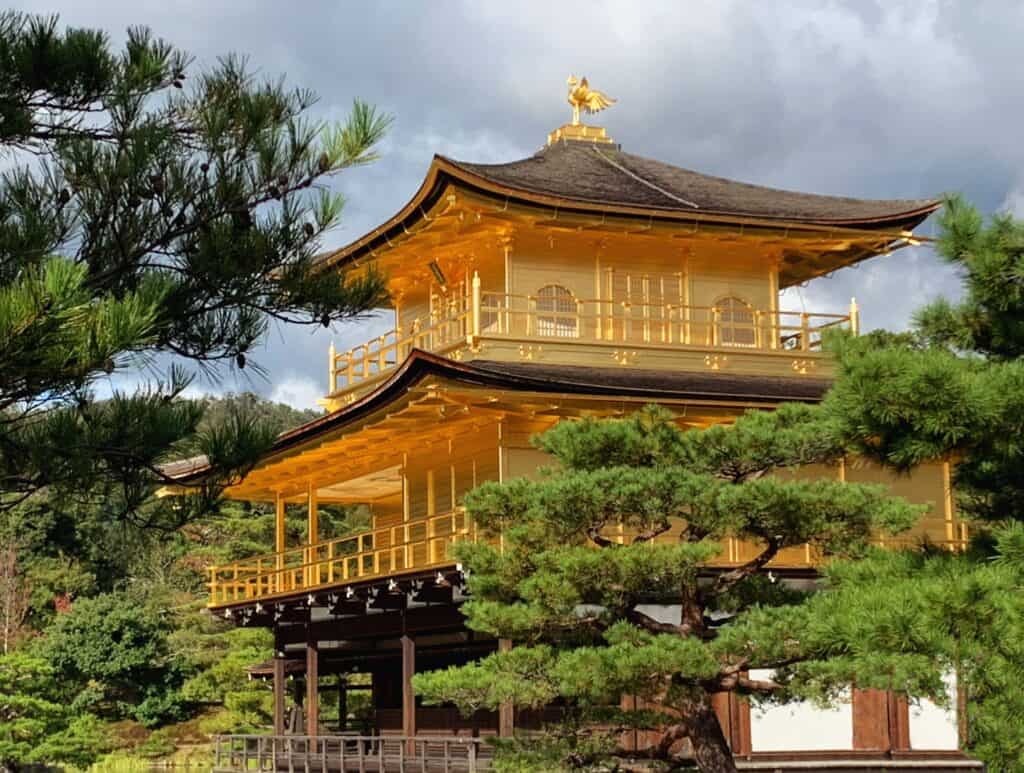
Putting a golden building into a refined Japanese garden sounds like a terrible idea, but somehow the Golden Pavilion works. The three-story hall is the centerpiece of a strolling garden set within the grounds of a palace-turned-temple complex. It’s also one of the most famous buildings in Japan, with enough crowds to turn off some visitors.
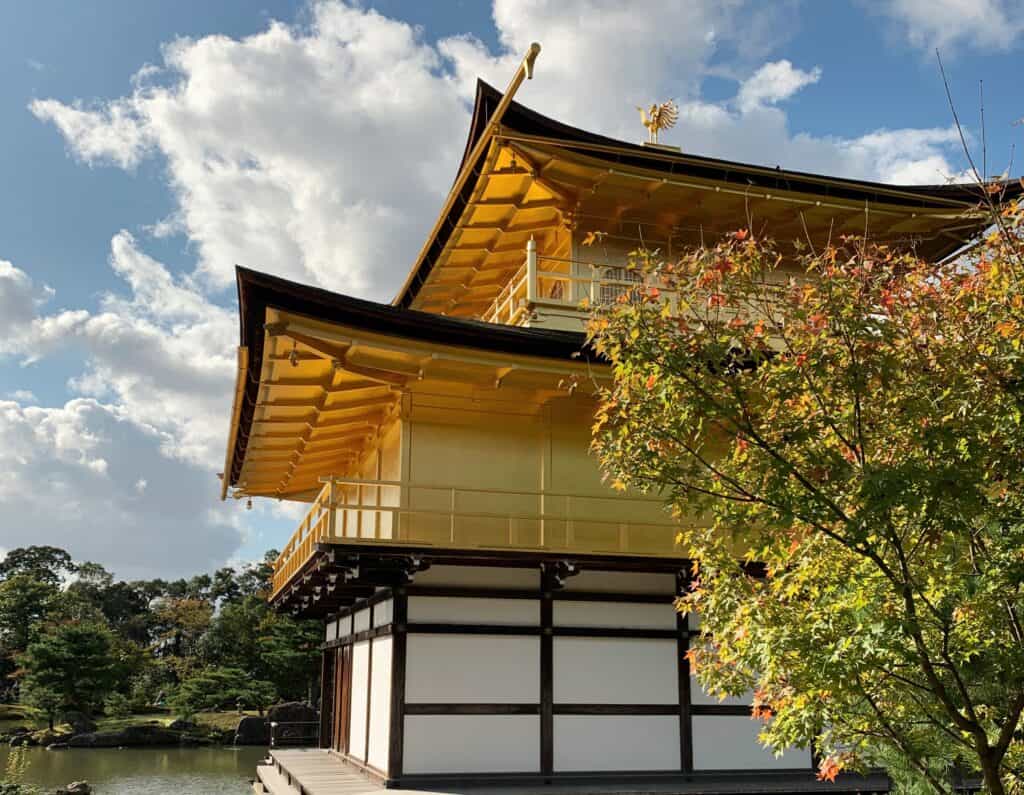
Shogun Ashikaga Yoshimitsu built the Golden Pavilion as part of his retirement villa around 1397. Impeccable positioning enables it to harmonize with the rest of the site; when framed by pine needles and reflected in the pond, it’s a vision of Pure Land Paradise. The building itself is a curious mixture: the lower level borrows from older palaces but uses simple wood and white plaster, while the gold-coated upper floors follow the styles of samurai residences and a Chinese Zen hall.
If possible, visit during the winter when it looks even better.
Getting to Kinkaku-ji via public transportation requires either a long walk or taking a (usually crowded) bus. For visiting information see the website.
Garden of Fine Arts and Kyoto Concert Hall
Two giants of post-war Japanese architecture contributed a pair of buildings adjacent to Kyoto’s wonderful Botanical Gardens. Tadao Ando’s 1994 Garden of Fine Arts features reproductions of eight masterpieces of art (six Western, two from East Asia) in an abstract version of a strolling garden.
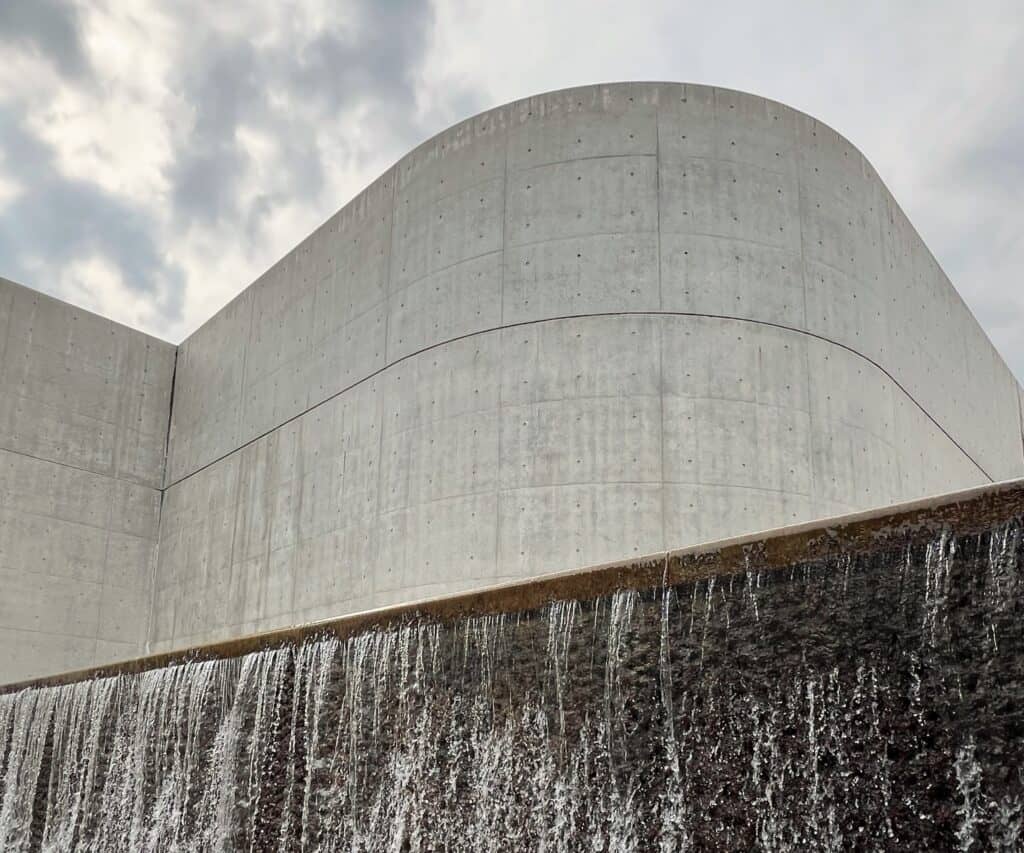
The mixture of levels and wall directions creates multiple vantage points, accented by water and other reflective surfaces. We appreciated the attempt to provide a more contemplative environment for the paintings, even if the structure itself seemed to take over at times.


The design for Arata Isozaki’s 1995 concert hall follows a standard Western ‘shoebox’ layout for concert halls, with a few gestures towards Japanese heritage in the materials (black ceramic on the exterior, wood slats in the main hall). The subtle angles of the spiral ramp show Isozaki’s ability to sculpt space. Unfortunately, the building was surrounded by construction when we visited.
Take the Karasuma Line to Kitaoji Station. For more information, see the Garden of Fine Arts and Kyoto Concert Hall websites.
International Conference Center (ICC)
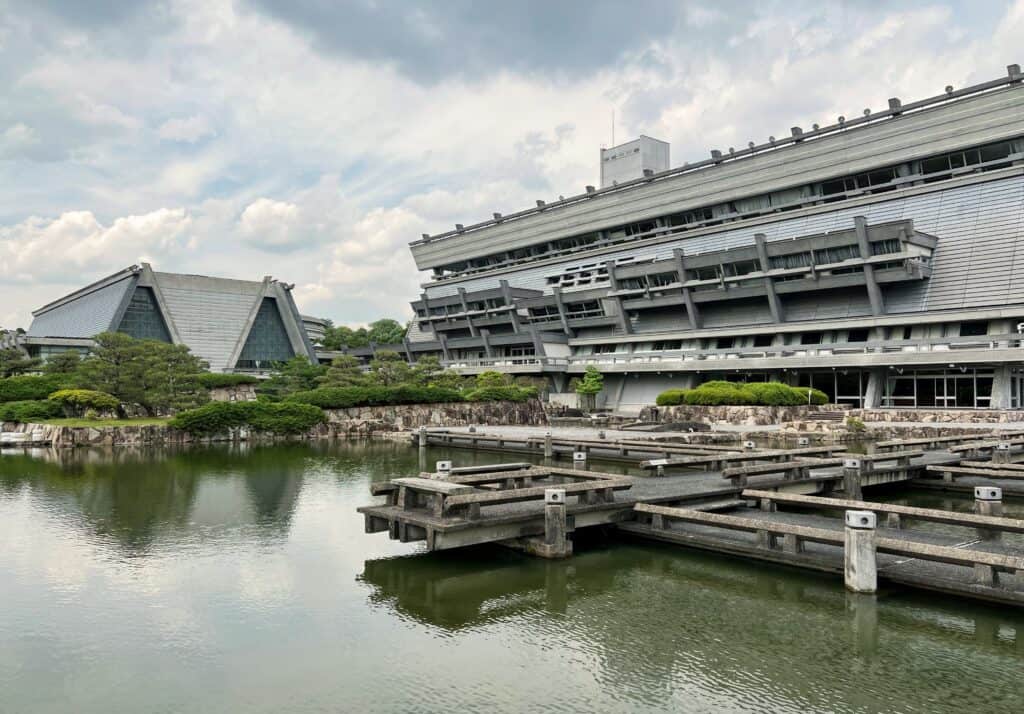
With its wealth of historic architecture, Kyoto seems like an unlikely place to put a behemoth modern conference center. But the ICC blends elements from traditional Japanese architecture into its concrete megastructures. Because its vision of the future never abandoned the past, the 1963 design has aged remarkably well. Not only does it continue to function as a convention venue (famously hosting the Kyoto Protocol), but it attracts locals and design lovers when it opens to the public- usually three days per month.
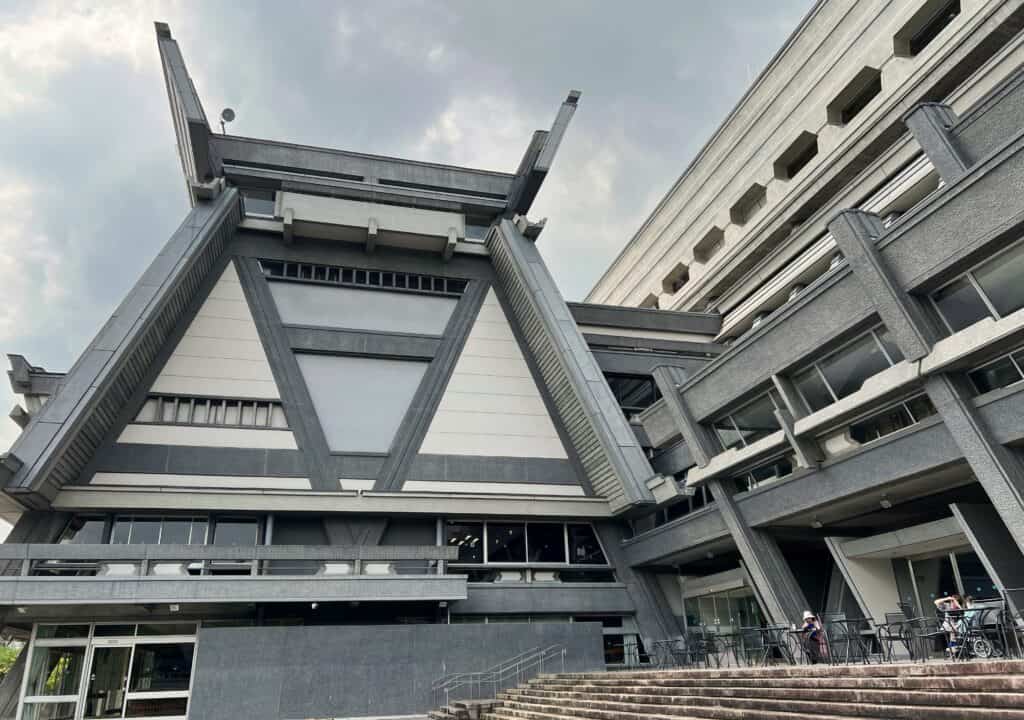
The ICC’s major structures feature slanted walls which echo the surrounding mountains. Deep overhangs evoke temple roofs. Even the furniture by Isamu Kenmochi continues the act with portable barriers modeled on inu-yarai, the dog-repelling bamboo fences found on the facades of traditional Kyoto townhouses.


Architect Sachio Otani helped develop Metabolism, post-war Japan’s version of Brutalist architecture. Unlike the more strident members of the movement, however, he focused on integrating his designs into the existing environment. Taking a cue from the property’s position on Lake Takaragaike, Otani designed an outdoor area with concrete walkways crisscrossing over the water: a modern take on Japanese gardens and a transition from human construction to the natural world.
The ICC is located next to the Kokusaikaikan subway stop. Open days and visiting information are posted on the website.
Southern Kyoto and Uji
Katsura Imperial Villa
Katsura Imperial Villa is one of the best examples of traditional Japanese design as well as a major influence on Modernist architecture across the world. The estate encompasses a three-section palace, half a dozen teahouses, and assorted gates, all meticulously incorporated into the surrounding gardens. Two generations of imperial princes supervised the design in the early to mid-1600’s.
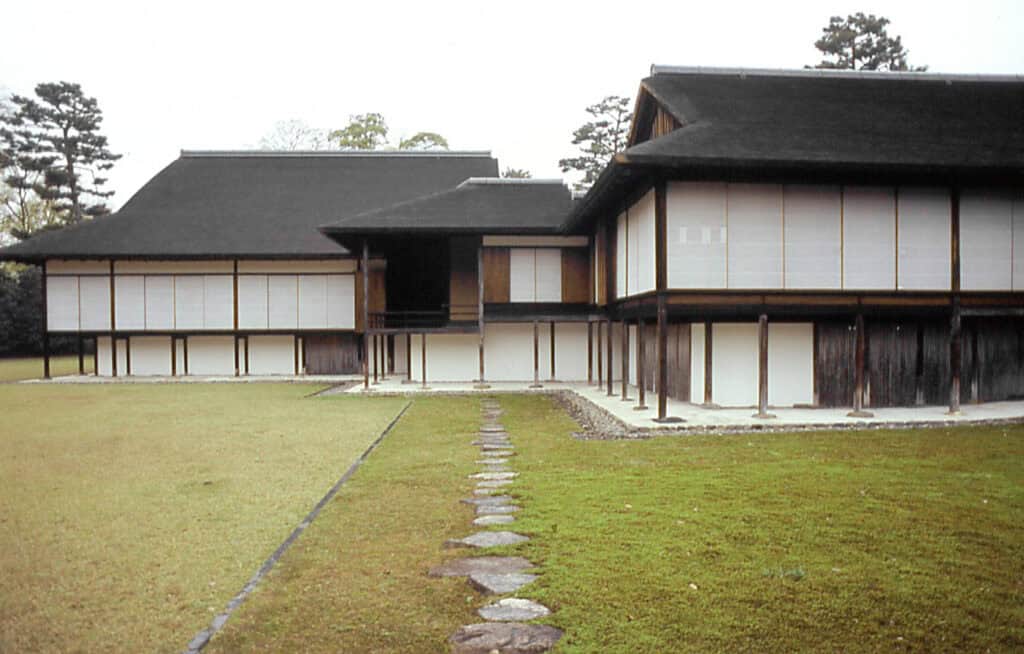
With the spread of Zen Buddhism and the rise of the shogun, Kyoto’s aristocracy focused more and more on aesthetics. In contrast to the warrior classes’ displays of wealth and power, the nobility celebrated rusticity and quiet contemplation. Raw materials and irregular forms provided a connection to the natural world.
Visiting the palace requires registering for a tour through the site. Palace buildings can only be seen from the outside, and photography is limited to certain spots. For more information, see the website.
Fushimi Inari
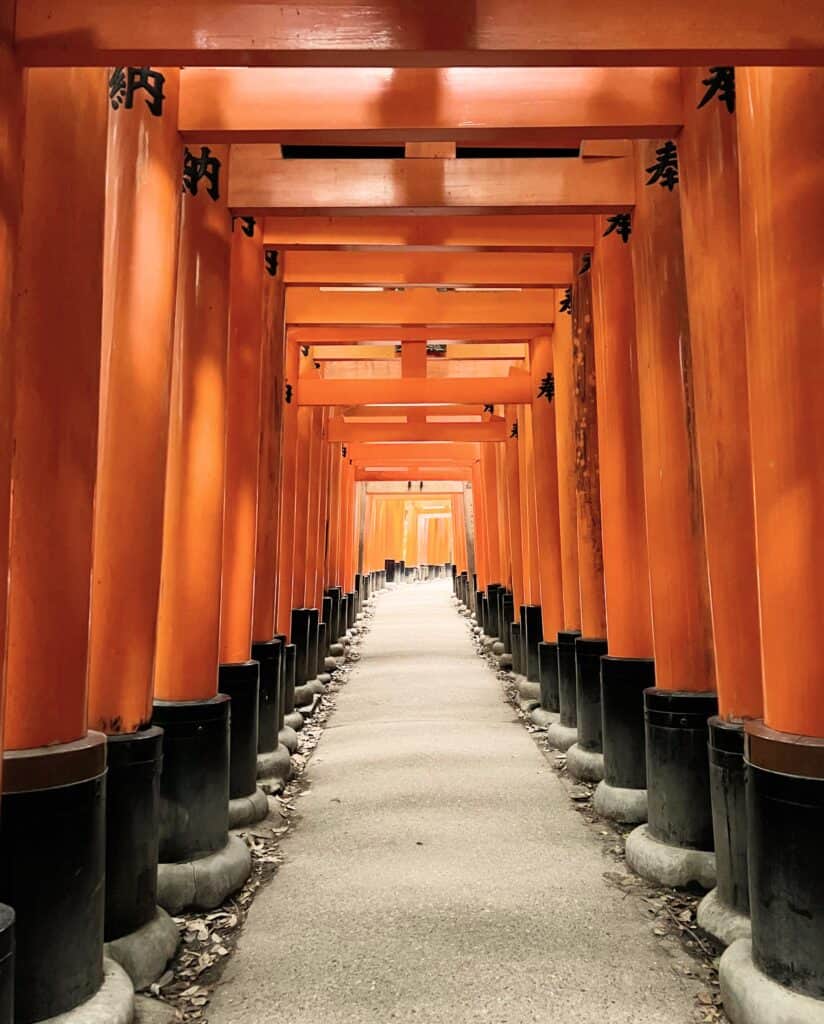
Fushimi Inari Taisha is a 1300 year-old complex of Shinto shrines sprawling across Inariyama, the final peak of Kyoto’s eastern mountain range. The most important of Japan’s 30,000 shrines honoring the rice deity Inari draws pilgrims from all over the country. Fushimi Inari has also become a destination for more than ten million tourists every year.
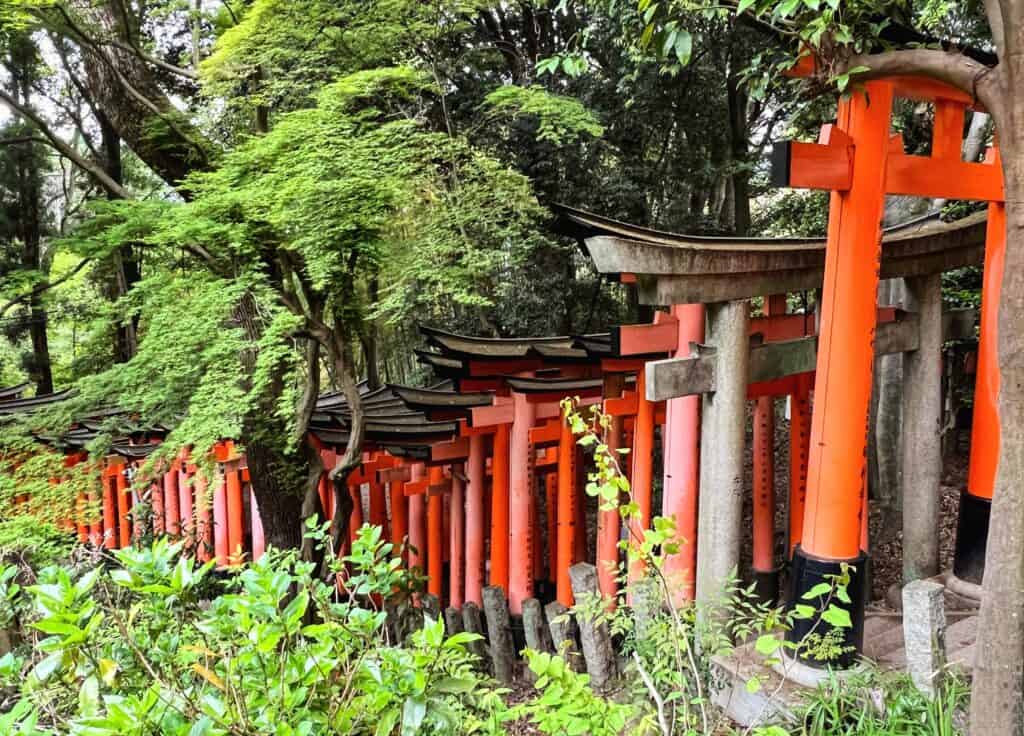
Thousands upon thousands of red-orange torii gates form otherworldly pathways between its shrines, each presided over by a pair of fox statues. The grand Romon gateway marks the entrance, leading to the main shrine at the foot of the slope. Behind it the Senbon Torii (Thousand Gates) wind through the forest, clustering densely enough to create a tunnel effect.
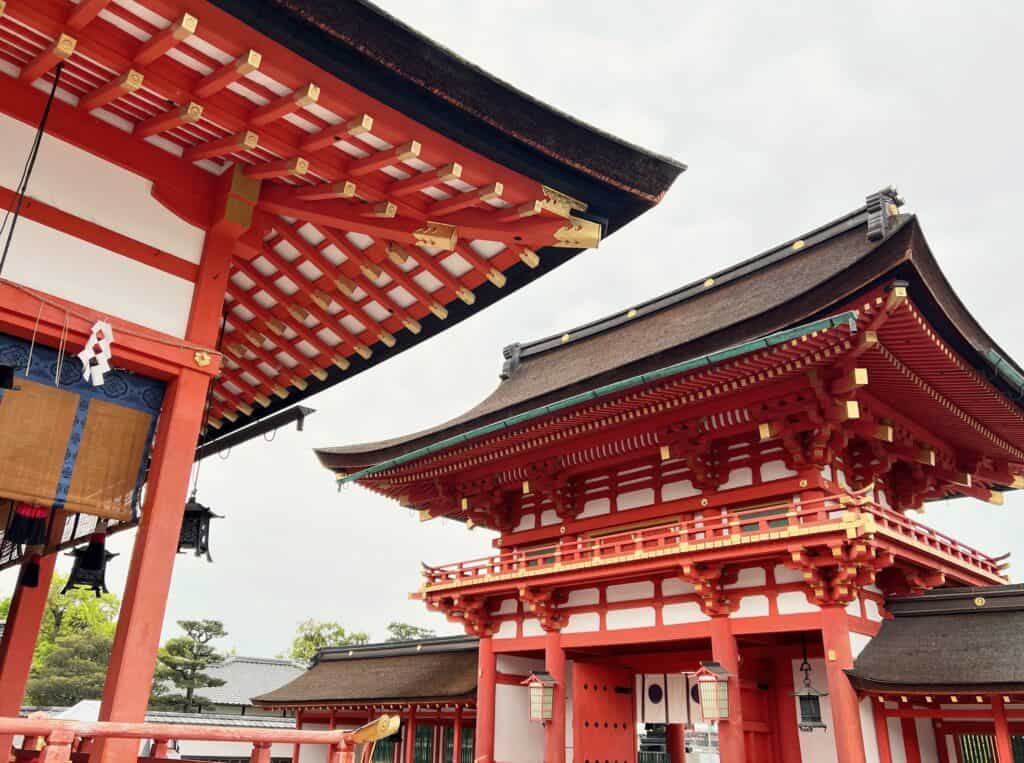
A prayer area known as Inari Okusha marks the end of the Senbon Torii. At this point the path begins climbing up the mountain and the torii gates gradually begin to thin. It’s worth exploring some of the shrines dotting the mountainside. Many feature miniature torii shapes stacked against the old stone altars as well fox statues decked out in red bibs. These smaller shrines add an intimate dimension to the site and range from freshly-swept shelters to carved stones disappearing in a fuzz of moss.
For tips on avoiding the crowds, see our article When to Visit Kyoto’s Fushimi Inari: Early Morning vs. Night
Daigo-ji
This 1,150 year-old temple complex boasts some of Kyoto’s most historic architecture along with breathtaking gardens and stunning views. With multiple listed cultural assets and National Treasures, it also qualifies as a UNESCO World Heritage Site. Yet because it looks remote on tourist maps, Daigo-ji remains crowd-free.
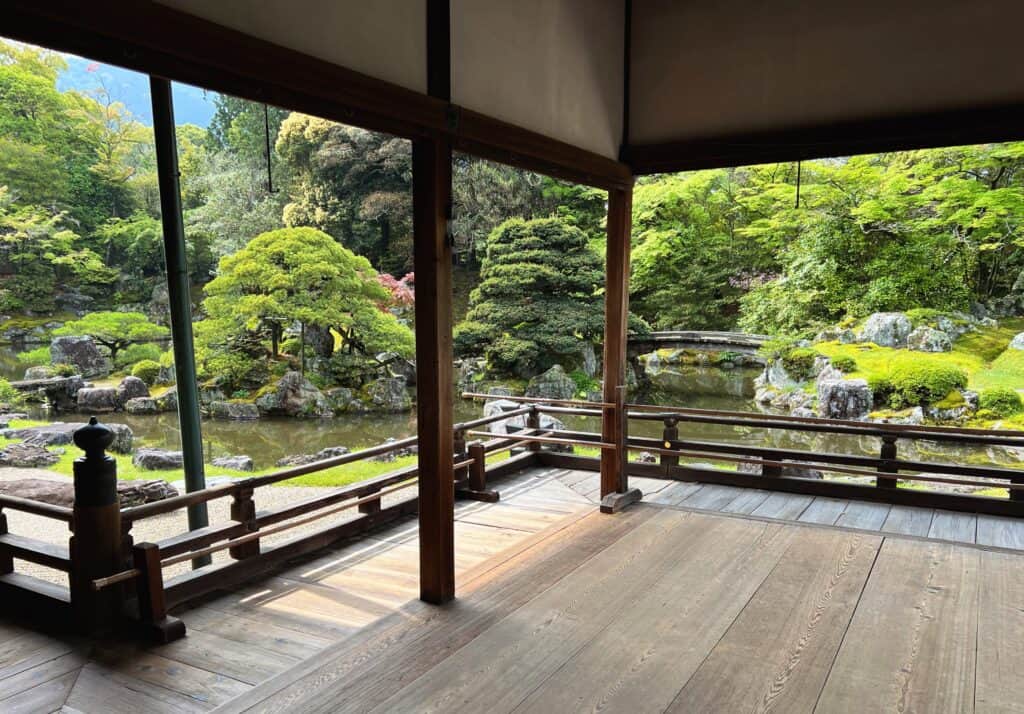
The enormous site becomes progressively older and less landscaped moving up the mountain. The lower level begins with the Sanbo-in section, where Totoyomi Hideyoshi famously hosted cherry blossom viewing parties. Nio Gate leads back to the Garan Area and its Five-storied Pagoda. Although the version at To-ji Temple is taller, Daigo-ji’s pagoda – circa 951 – is Kyoto’s oldest wooden structure.
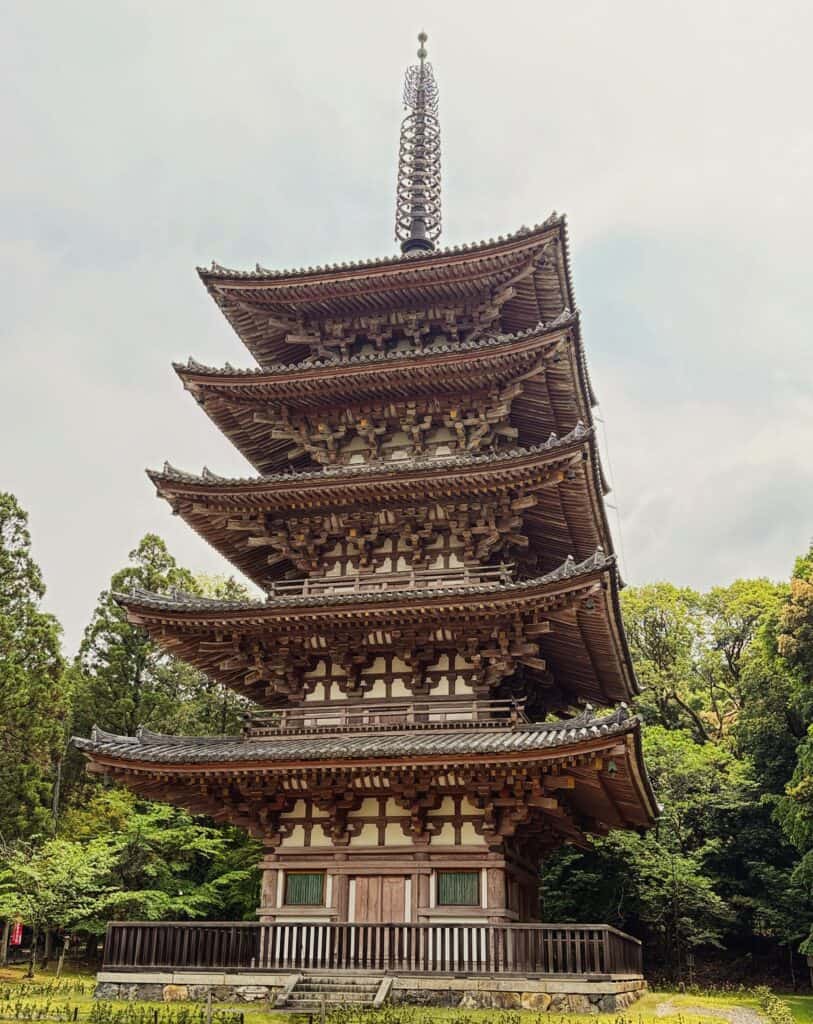
At the end of the lower section lies an iconic viewpoint of tiny Benten-do Hall and a curving vermilion bridge, in perfect harmony with the pond and landscaping.
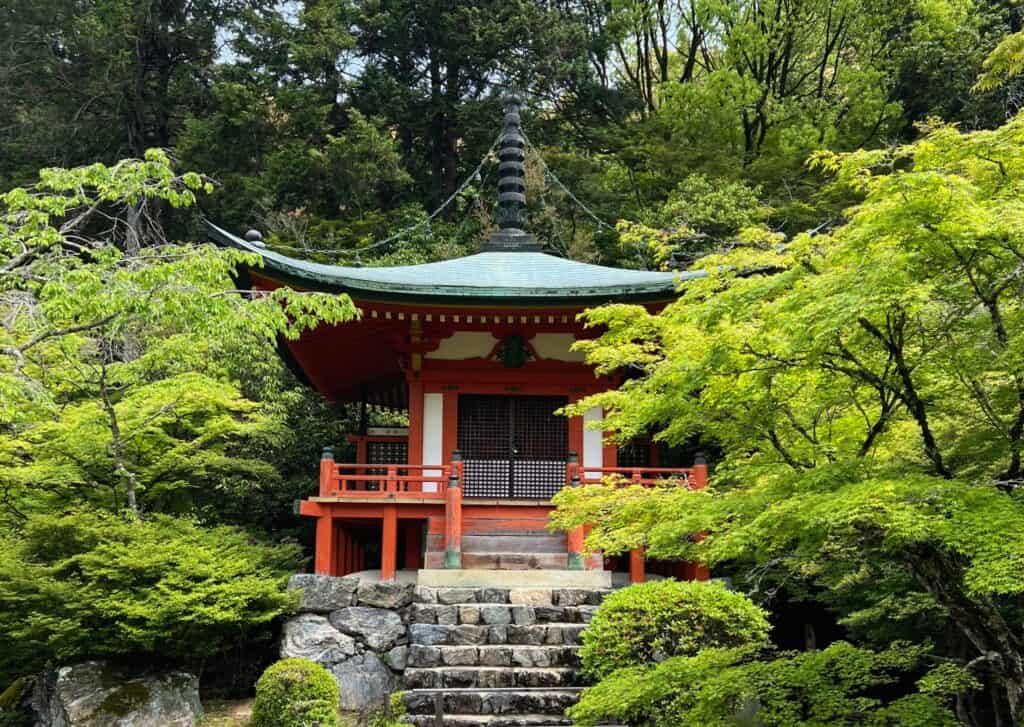
A rigorous one-hour hike leads from the Shimo Daigo (Lower Part) to the Kami Daigo (Upper Part). A handful of smaller buildings plus expansive views reward the climb. Daigo-Sui houses the spring where the temple began in 874.
It takes about 10-15 minutes to walk to the temple from the Daigo Station (on the Tozai/green subway line). For visiting information see the Daigo-ji website.
Hall of the Phoenix at Byodo-in, Uji
The Hall of the Phoenix is more than a rare survivor from the Heian period – it’s one of the major reasons the era is known as Japan’s Golden Age. The property originally served as the summer residence of courtier Fujiwara Michinaga, who probably inspired the title character in The Tale of Genji. In 1053 his son converted the villa into a temple complex, anchored by one of the world’s most elegant structures.
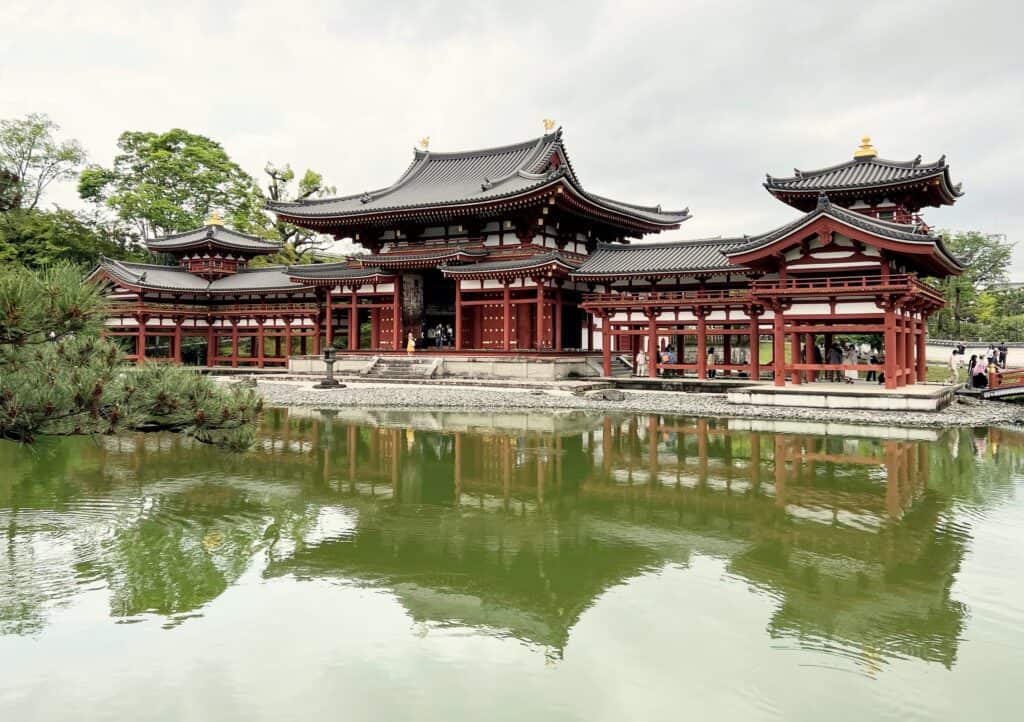
It’s not hard to see why Byodo-in’s Amida Hall picked up the nickname Hall of the Phoenix: the entire building looks like a bird taking flight. Unfurling wings flank the tall core, and there’s even a section sticking the rear out like a tail. The entire lower level is open, making the upturned roofs seem to hover, and the pond reflects sky instead of earth underneath them.
Guided tours allow visitors inside the hall to see the renowned Buddha; currently some of the Byodo-in’s other buildings are closed for renovations. For visiting information, see the Byodo-in website.
Uji is a suburb of Kyoto, about 20 minutes south on the Keihan or JR Line train lines.
Further Reading
Kyoto: Seven Paths to the Heart of the City has brief itineraries covering historic preservation zones, some more well-known than others. It also includes an excellent description of kyo-machiya townhouses.

